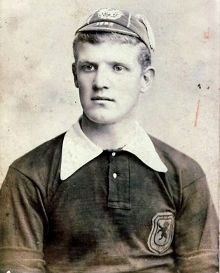John (Jacky) Tait Robertson

Jacky Robertson might on the face of it seem to be one of the few Dumbarton-born players that got away. In fact it was the Robertsons, who seem to have moved not just from the town itself but from the Vale of Leven as a whole. Robertson Snr was a Shipyard driller born in Renton. His mother was born in Alexandria. And whilst Jacky came into this World towards the bottom end of Dumbarton High St., the family moved first to the west of the town, then to the east before settling outwith it altogether in Govan. In part that might explain why the young Robertson never played for the town of his birth, although he did begin in 1892, aged 15, in it with a team said to be called "Pointfield" but probably Poindfauld.
But such was his talent that at seventeen he was signed by his first senior club, Morton, albeit for just a season before heading South, recruited by Everton. In fact he, an attack-minded half-back, had been bought to be brought through slowly. He did not play First Team for the Mersey-siders until 1897, so two years more, aged twenty, and even then it was not for long. Although that season he would play almost a full complement of games plus winning a first cap at barely twenty-one and against England he also became associated with the formation of the Association Footballers' Union and was one of the players to move or be moved on. He was to go to Southampton, outwith the Football League and its wage-cap and there was in the team that, as he personably would be awarded a second cap, take the Southern League title.
And that was when Rangers came in for him and where he would finally settle, spending the next six seasons at Ibrox, his family living literally a couple of streets from the stadium. With the Gers he would make over a hundred League appearances, one hundred and seventy-eight in all, win three League title, almost a fourth, the Scottish Cup, fourteen more caps and be Scotland's captain five times before leaving the club aged just twenty-eight, and to head South once more. In April 1905 he was appointed player-manager, recorded as Secretary-Manager, of the newly formed, in fact created, Chelsea. Indeed he was their first player, would score the club's first goal and in the first season take it to one place of promotion. Yet, already from third spot at the start of the next next season in November 1906 he resigned. Reasons are hard to fathom, even if such resignations/sackings have not been exactly a rarity at Stamford Bridge. And he did it having just moved to London but returning to Rutherglen to marry Edith Ferguson.
In fact, as Chelsea was then promoted at the end of the season with the team he had effectively built, he first took a year off before in 1907 becoming player-manager of struggling Glossop, moving the family to North England, staying with the club for two seasons, rebuilding once more and taking it from fifteenth to eighth. But clearly all was not well and in 1909 he left and by accepting the post of reserve team trainer at Manchester United for two more looked to have taken a step down. However, events then took perhaps a surprising turn. With sponsorship from a London company and the President of the MTK club in Budapest in 1911 he was offered and took the job of coach to the club itself, winning the Hungarian Cup in his first season and twice finishing runners-up in the league. It is said that he brought to Hungarian football physical conditioning and technical innovation. He certainly paved the way for the arrival in 1914 of Jimmy Hogan, the man considered by the Hungarians as making their game.

But on returning to Britain in 1913 for John Tait that seems to have been it in terms of the football, if not sport. Immediately after the Great War with the family now including four children, three girls and a boy, one born in Lancashire, the three younger ones later in Scotland, he had come back Glasgow and was working, now in his forties, as, albeit temporarily, a caulker and electric welder, presumably in the shipyards. In fact he would later turn his hand to journalism, becoming a successful sports-writer and it was as such that in 1935 he would pass away, in hospital, of cancer and just a month before his fifty-eight birthday. He is buried in Rutherglen Cemetery, outlived by Edith by a dozen years.
Birth Locator:
1877 - 42, High St., Dumbarton
Residence Locations:
1881 - 40, West Bridgend, Dumbarton
1891 - 11, Wallace St., Dumbarton
1901 - (31, Copland Rd. Govan, Glasgow)
1905 - 41, Moore Park Road, Fulham, London
1911 - 8, North Lonsdale Street, Stretford, Manchester
1911 - To Budapest, Hungary
1921 - 62, Kelvinhaugh Rd., Glasgow
1935 - 255, Greenhead St., Glasgow
Death Locator:
1935 - Royal Cancer Hospital, Milton, Glasgow
Grave Locator:
Rutherglen Cemetery, Rutherglen, Scotland - Section E Lair 786
Back to Dumbarton
to the Leven Trails,
or the SFHG Home page